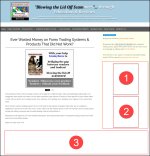- Home
- Trading Strategies
- volatility and risk in finance
volatility and risk in finance
by Juergen Lahnsteiner
(Vienna, Austria)
As everybody knows volatility is a measure for average price fluctuations. In other words, it is a measure for average daily percentage change in closing prices. Many times experts use it as a risk measure by telling you that high volatility implies high risk. In my opinion this is one of the biggest mistakes in investment theory. Why?
Lets take an example: in year xy some FX quote changed by 50% - up or down - and therefore displayed very high volatility, which means that this pair is now considered very risky to invest in. How can extreme movements with chances for huge wins result in high risk? It's even more obvious with stocks. Why can a stock that rose by 50% be considered very risky? See the problem? Risk theory treats upward and downward movements in exactly the same way. So if you just look at volatility data, you will not know if a currency pair or stock doubled its quotation or if it went down by 50%.
So if volatility is no good when measuring risk, what is volatility good for and how can risk be measured effectively? In my opinion risk is never a characteristic of a certain stock or forex quote, it is a characteristic of the model you use to predict price movements. Lets assume an extreme case:
You possess a prediction model or a crystal ball which enables you to forecast price movements with an accuracy of 100%. What are you going to invest your money in? Certainly in the most volatile currency pair or stock you can find since the high daily price movements will help you earn a fotune. How about an accuracy of 60%? Same answer! If you can be sure that 6 out of 10 trades are "right", no matter if selling or buying, you will end up with more money if you invest in very volatile than in less volatile currency pairs/stocks. As you can see the risk lies in the accuracy of your predictions. How about an accuracy of around 50%? By investing at 50% accuracy level you might win, but you might as well lose. If you invest in highly volatile stock you'll win/lose more than when investing in low volatility stock. This is basically all volatility is about - the LEVEL of gains/losses - not the FACT, if you win or lose. The FACT is always caused by your prediction quality.
However, who would invest with a 50% model? I would not. You might as well play roulette. The first thing is to find a prediction model with high accuracy, then you pick high volatility currency pairs or stocks which you can forecast at that high accuracy level. To spread risk you invest your money in more than one stock/currency pair, probably 5 to 10. This will help keep off ugly surprises. As shown above, low volatility won't help you reduce risk. It is going to help reduce losses if you suffer them. With good predictions this won't happen.
If you intend to follow a buy and hold strategy the problem is a totally different one: you have to find a currency pair (=a country and/or its economy) or a company with good prospects for the future. This doesn't have anything to do with volatility! It is a matter of fundamental data, industry outlooks, technological development, politics etc. So no matter how you look at it: as a day trader or as a long-term buy-hold investor - volatility NEVER is a measure of risk. I perfectly well know that this is hard to get out of peoples minds but I certainly hope to make some readers think about this problem. If they do, they'll find out that textbook wisdom on investment theory is definitely wrong in this point.
Juergen Lahnsteiner
email: juergenlahnsteiner@gmail.com
twitter.com/jl_ebensee
Comments for volatility and risk in finance
|
||
|
||





